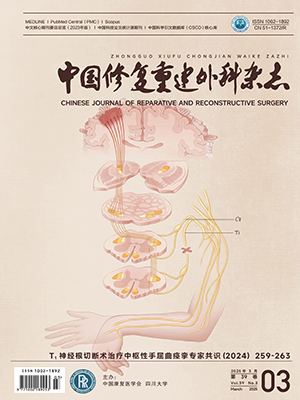| 1. |
Rabei R, Patel K, Ginsburg M, et al. Percutaneous vertebral augmentation for vertebral compression fractures: national trends in the medicare population (2005-2015). Spine (Phila Pa 1976), 2019, 44(2): 123-133.
|
| 2. |
Song W, Seta J, Eichler MK, et al. Comparison of in vitro biocompatibility of silicone and polymethyl methacrylate during the curing phase of polymerization. J Biomed Mater Res B Appl Biomater, 2018, 106(7): 2693-2699.
|
| 3. |
Ridwan-Pramana A, Idema S, Te Slaa S, et al. Polymethyl methacrylate in patient-specific implants: description of a new three-dimension technique. J Craniofac Surg, 2019, 30(2): 408-411.
|
| 4. |
Wang B, Lin Q, Shen C, et al. Hydrophobic modification of polymethyl methacrylate as intraocular lenses material to improve the cytocompatibility. J Colloid Interface Sci, 2014, 431: 1-7.
|
| 5. |
Hesaraki S, Safari M, Shokrgozar MA. Composite bone substitute materials based on beta-tricalcium phosphate and magnesium-containing sol-gel derived bioactive glass. J Mater Sci Mater Med, 2009, 20(10): 2011-2017.
|
| 6. |
Le Ferrec M, Mellier C, Boukhechba F, et al. Design and properties of a novel radiopaque injectable apatitic calcium phosphate cement, suitable for image-guided implantation. J Biomed Mater Res B Appl Biomater, 2018, 106(8): 2786-2795.
|
| 7. |
Meng HS, Chen C, Yan ZR, et al. Co-doping polymethyl methacrylate and copper tailings to improve the performances of sludge-derived particle electrode. Water Res, 2019, 165: 115016.
|
| 8. |
Sun X, Wu Z, He D, et al. Bioactive injectable polymethylmethacrylate/silicate bioceramic hybrid cements for percutaneous vertebroplasty and kyphoplasty. J Mech Behav Biomed Mater, 2019, 96: 125-135.
|
| 9. |
Dalby MJ, Di Silvio L, Harper EJ, et al. In vitro adhesion and biocompatability of osteoblast-like cells to poly (methylmethacrylate) and poly (ethylmethacrylate) bone cements. J Mater Sci Mater Med, 2002, 13(3): 311-314.
|
| 10. |
De S, Vazquez B. The effect of cross-linking agents on acrylic bone cements containing radiopacifiers. Biomaterials, 2001, 22(15): 2177-2181.
|
| 11. |
Miyazaki T, Ohtsuki C, Kyomoto M, et al. Bioactive PMMA bone cement prepared by modification with methacryloxypropyltrimethoxysilane and calcium chloride. J Biomed Mater Res A, 2003, 67(4): 1417-1423.
|
| 12. |
Fukuda C, Goto K, Imamura M, et al. Bone bonding ability and handling properties of a titania-polymethylmethacrylate (PMMA) composite bioactive bone cement modified with a unique PMMA powder. Acta Biomater, 2011, 7(10): 3595-3600.
|
| 13. |
Darwish G, Huang S, Knoernschild K, et al. Improving polymethyl methacrylate resin using a novel titanium dioxide coating. J Prosthodont, 2019, 28(9): 1011-1017.
|
| 14. |
Wang Z, Li Z, Zhang X, et al. A bone substitute composed of polymethyl-methacrylate bone cement and Bio-Gene allogeneic bone promotes osteoblast viability, adhesion and differentiation. Biomed Mater Eng, 2021, 32(1): 29-37.
|
| 15. |
Akbay A, Bozkurt G, Ilgaz O, et al. A demineralized calf vertebra model as an alternative to classic osteoporotic vertebra models for pedicle screw pullout studies. Eur Spine J, 2008, 17(3): 468-473.
|
| 16. |
Pneumaticos SG, Triantafyllopoulos GK, Evangelopoulos DS, et al. Effect of vertebroplasty on the compressive strength of vertebral bodies. Spine J, 2013, 13(12): 1921-1927.
|
| 17. |
尹知训, 丁红梅, 靳安民, 等. 胸腰椎骨质疏松压缩性骨折经椎弓根植骨的生物力学研究. 中国临床解剖学杂志, 2008, 26(2): 196-198.
|
| 18. |
Sun K, Liebschner MA. Evolution of vertebroplasty: a biomechanical perspective. Ann Biomed Eng, 2004, 32(1): 77-91.
|
| 19. |
Oner FC, Verlaan JJ, Verbout AJ, et al. Cement augmentation techniques in traumatic thoracolumbar spine fractures. Spine (Phila Pa 1976), 2006, 31(11 Suppl): S89-95.
|
| 20. |
Kim YY, Rhyu KW. Recompression of vertebral body after balloon kyphoplasty for osteoporotic vertebral compression fracture. Eur Spine J, 2010, 19(11): 1907-1912.
|
| 21. |
Wang YT, Wu XT, Chen H, et al. Adjacent-level symptomatic fracture after percutaneous vertebral augmentation of osteoporotic vertebral compression fracture: a retrospective analysis. J OrthopSci, 2014, 19(6): 868-876.
|
| 22. |
Yi X, Lu H, Tian F, et al. Recompression in new levels after percutaneous vertebroplasty and kyphoplasty compared with conservative treatment. Arch Orthop Trauma Surg, 2014, 134(1): 21-30.
|
| 23. |
谢华, 李继春, 何劲, 等. 骨水泥分布对椎体成形手术后疗效影响的研究. 中华骨科杂志, 2017, 37(22): 1400-1406.
|
| 24. |
Robo C, Öhman-Mägi C, Persson C. Compressive fatigue properties of commercially available standard and low-modulus acrylic bone cements intended for vertebroplasty. J Mech Behav Biomed Mater, 2018, 82: 70-76.
|
| 25. |
Gutiérrez-Mejía A, Herrera-Kao W, Duarte-Aranda S, et al. Synthesis and characterization of core-shell nanoparticles and their influence on the mechanical behavior of acrylic bone cements. Mater Sci Eng C Mater Biol Appl, 2013, 33(3): 1737-1743.
|
| 26. |
Boger A, Bohner M, Heini P, et al. Properties of an injectable low Modulus PMMA bone cement for osteoporotic bone. J Biomed Mater Res Part B Appl Biomater, 2008, 86(2): 474-482.
|
| 27. |
Boger A, Bisig A, Bohner M, et al. Variation of the mechanical properties of PMMA to suit osteoporotic cancellous bone. J Biomater Sci Polym Ed, 2008, 19(9): 1125-1142.
|
| 28. |
Robo C, Hulsart-Billström G, Nilsson M, et al. In vivo response to a low-modulus PMMA bone cement in an ovine model. Acta Biomater, 2018, 72(5): 362-370.
|




